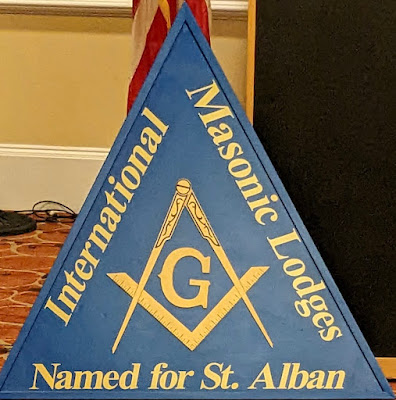St. Alban Lodge 529 in Philadelphia celebrates its sesquicentennial anniversary this year, in part, by hosting the 71st Annual International Gathering of Lodges Named for St. Alban. This will be the weekend of September 13 at the Masonic Temple in the City of Brotherly Love.
In Freemasonry, there used to be an interesting practice of lodges sharing a common name, but that are spread across grand jurisdictions around the country, uniting in a chain and occasionally meeting for fellowship—and, I guess, celebrating how their lodges’ name rocks. For example, there once was a St. John’s Lodge brotherhood.
Of course, the Holy Saints John are integral to Masonic ritual and symbolism, and I imagine every grand lodge in the United States has a St. John’s Lodge, very often numbered first. New York’s eldest extant lodge is St. John’s 1 in Manhattan, dating to 1757.
There is another saint whose name figures prominently in lodge nomenclature around America and beyond: St. Alban. His presence in Masonic culture is not obvious. First, let’s look at some biography, courtesy of Catholic Encyclopedia. Excerpted:
St. Alban. First martyr of Britain, suffered c. 304. The commonly received account of the martyrdom of St. Alban meets us as early as the pages of Bede’s “Ecclesiastical History” (Bk. I, chs. vii and xviii). According to this, St. Alban was a pagan living at Verulamium (now the town of St. Albans in Hertfordshire), when a persecution of the Christians broke out, and a certain cleric flying for his life took refuge in Alban’s house. Alban sheltered him, and after some days, moved by his example, himself received baptism. Later on, when the governor’s emissaries came to search the house, Alban disguised himself in the cloak of his guest and gave himself up in his place. He was dragged before the judge, scourged, and, when he would not deny his faith, condemned to death. On the way to the place of execution Alban arrested the waters of a river so that they crossed dry-shod, and he further caused a fountain of water to flow on the summit of the hill on which he was beheaded. His executioner was converted, and the man who replaced him, after striking the fatal blow, was punished with blindness. A later development in the legend informs us that the cleric’s name was Amphibalus, and that he, with some companions, was stoned to death a few days afterwards at Redbourn, four miles from St. Albans.
With Freemasonry arising in the British Isles, it is easy to understand how the first martyr in Britain could be cited as a kind of spiritual founding father. The earliest mention of him in Masonic literature is found in the Cooke Manuscript from the early 1400s, which is the second oldest known publication in Masonic letters, junior only to the Regius MS, and is the oldest of the Gothic Constitutions. It echoes in Anderson’s Constitutions and in the ritual probably used in your lodge. Cooke, at line 602, briefly says:
“And soon after that came Saint Adhabell into England, and converted Saint Alban to Christianity. And Saint Alban loved well masons, and gave them their first charges and manners first in England. And he ordained convenient [times] to pay for the travail.” (Spelling modernized.)
Another document, known as the Grand Lodge Manuscript, that is said to date to 1583, illustrates more:
England in all this time stood void of any Charge of Masonry, until St. Albons’ time, and in his days the King of England, then a pagan, did wall the town that is now called St. Albons. And St. Alban was a worthy Knight and Steward of the King’s household, and had the government of the realm, and also of the walls of the said town; he loved and cherished Masons right well, and made their pay right good (according the standing of the realm), for he gave them 2 shillings 6 pence a week and three pence to their cheer [food and drinks]; for before that time, throughout all the land, a Mason took but a penny a day and his meat, until St. Alban amended it. He procured for them [the Masons] a Charter from the King and his Council, to hold a general council together, and gave it the name of Assembly; and after having himself [become a Mason], he helped to make men Masons, and gave them a Charge, as you shall hear afterwards right soon.
Personally, I believe St. Alban endeared himself to masons through the act of improving the food and drink allowance! His feast day is June 22. Vivat!
A quick look through a search engine shows there are St. Albans lodges at labor in Connecticut, Maryland, Massachusetts, North Carolina, Ontario, Pennsylvania, Quebec, Rhode Island, Texas, Vermont, West Virginia and, of course, St. Albans in Hertfordshire!
To register for the Philadelphia event, click here.





































































